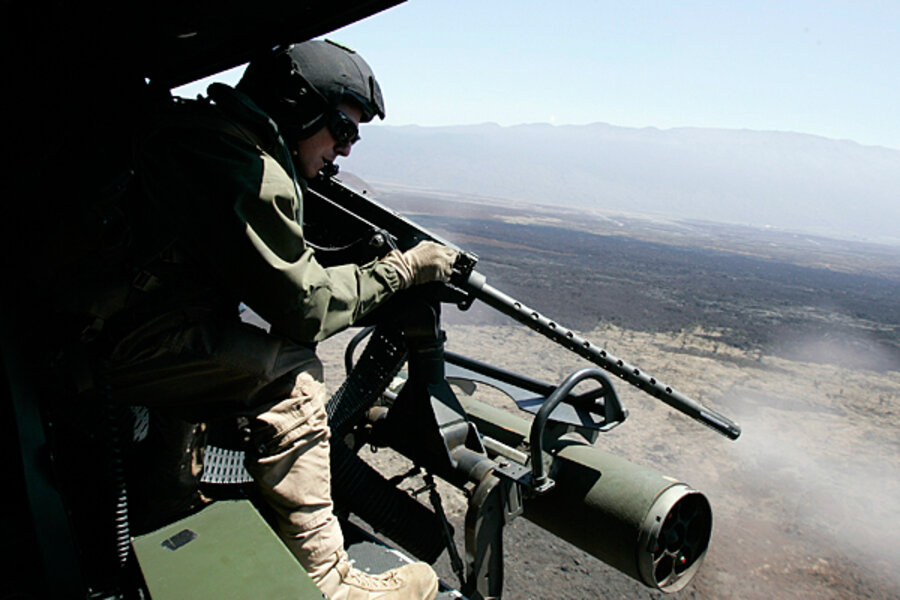Gun control: Why the US military is fighting with the NRA
Loading...
| Washington
US military commanders are increasingly expressing frustration with the National Rifle Association for blocking what they feel are vital measures to keep troops safe.
The controversy revolves around the surge in suicide within the armed forces. The Pentagon is facing an “epidemic,” Defense Secretary Leon Panetta told lawmakers this week, with some 206 US troops suspected of taking their own lives so far this year.
“That is an epidemic,” he said. “Something is wrong.”
As they cast about looking for possible ways to bring down the rates of suicide, commanders say that the answer may lie in having candid discussions with their soldiers about their personal firearms--and to take personal weapons away from those who appear likely to hurt themselves.
“The majority of [suicides] have two things in common: Alcohol and a gun. That’s just the way it is,” General Peter Chiarelli, the Army’s former Vice Chief of Staff, told the Monitor this January, shortly before he retired. “And when you have somebody that you in fact feel is high risk, I don’t believe it’s unreasonable to tell that individual that it would not be a good idea to have a weapon around the house.”
The problem, say US military commanders, is that a new NRA-backed law prohibits them from engaging in discussions about weapons and safety.
“I am not allowed to ask a soldier who lives off-post whether that soldier has a privately-owned weapon,” Chiarelli says. The legislation took effect at the end of 2010.
While commanders are permitted to ask troops who appear to be an imminent danger to themselves or others about private firearms--or to suggest locking them temporarily in a base depot--the law requires that if the soldier denies that he or she is thinking about harming anyone, then the commander cannot pursue the discussion further, he adds.
Yet determining whether a service member is an imminent danger to himself or others has been an elusive and frustrating pursuit for the Pentagon.
“I’m struck by the number of folks who come in for behavioral health counseling and are rated as ‘low to medium risk’ [of harming themselves or others] and two weeks later commit the irrevocable act of suicide,” Chiarelli says.
Half of troops that killed themselves use firearms to end their life and “suicide in most cases is a spontaneous event” that is often fueled by drugs and alcohol. But “if you can separate the individual from the weapon,” he added, “you can lower the incidences of suicide.” [Editor's note: An earlier version of this paragraph used phrasing that left an incorrect impression about the number of military personnel who kill themselves.]
The problem, Chairelli says, is that “we have issues in even being able to do that.”
Officials from the Department of Veterans Affairs are backing US military officials in the matter. Commanders who have asked troops they feel are at risk to consider locking their firearms on base temporarily are making use of an important “stalling technique,” Jan Kemp, national mental health director for the VA, said at a conference late last year.
She pointed to a study that found that a large number of suicides are impulsive events. If someone plans to jump off a bridge and finds that the bridge is closed, “Studies show that they won’t go to another bridge,” says Dr. Kemp. “They will think about it.”
NRA spokesman Andrew Arulanandam says that the organization is “not conducting interviews at this time, in view of what happened in Colorado.”
Others add that the law is not meant to preclude commanders from talking about firearms. “Obviously, the intent of the law is not to preclude a commander from taking steps necessary to mitigate a suicidal or dangerous situation,” says Jared Young, Communications Director for Sen. Jim Inhofe (R) of Oklahoma, in an email. Senator Inhofe was the author of the legislation. Spokesman Young said the senator is “very concerned” about suicide within the military. “At the same time,” he adds, “individual rights must be protected.”
That said, Mr. Young adds that Sen. Ihofe has “reached out to the DOD and other interested parties to ensure that all concerns have been adequately addressed.” The Pentagon did not immediately respond to a question about what a changed policy should include.
In the meantime, some US military commanders say they need to find new ways to address rising rates of suicide. “In many circumstances, awareness of risk means removing firearms from those who we believe are at risk of harming themselves or others,” Brig. Gen. Jonathan Woodson, an Army Reserve physician and Assistant Secretary of Defense for Health Affairs, told the audience at a recent suicide prevention conference. “I would ask all of you at this conference to commit to making reasonable recommendations that will guide uniform policy that will allow the separation of privately-owned firearms from those believed to be at risk of suicide.







